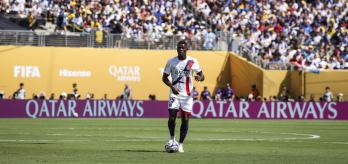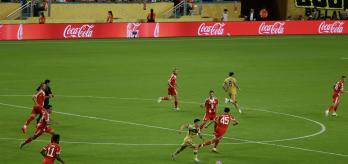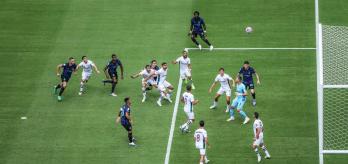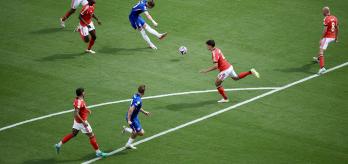Key findings
-
In the build-up phase, inverted full-backs were narrower when receiving the ball and attempted more line-breaking passes than traditional full-backs.
-
In the progression phase, inverted full-backs played more passes to wingers and completed more line-breaking passes than traditional full-backs.
-
In the final third, inverted full-backs made more offers to receive in behind their opponent’s defensive line and were involved in a greater number of passing sequences that led to attempts at goal.
INVERTED FULL-BACKS IN BUILD-UP PHASE
When their team is in the build-up phase, full-backs were recorded as being, on average, 4.4 metres narrower than traditional full-backs during the Club World Cup when receiving the ball. The higher up the pitch the build-up was occurring, the narrower they were (3.3 metres in low build-up, 4.8m in mid build-up, and 5.0m in high build-up).
Inverted full-backs received the ball more often, with an average of 14.2 receptions from possession actions (per 30 minutes in possession), compared to traditional full-backs, who had an average of just 4.7 receptions (P30IP) in the build-up phase. Inverted full-backs also attempted 1.3 more line breaks (P30IP) than traditional full-backs.
Inverting the full-backs overloads the midfield and improves forward-passing angles and options through the first line of the opposition’s defence. At the same time, the inversion can also preserve the attacking team’s rest-defence stability.
It should be noted that the player profile matters, with inverted full-backs often being elite counter-pressers who are agile, aggressive and able to recover quickly should the ball be turned over. Positioning them inside can place a team’s best ball-recovering athletes closest to the ball at the moment of the turnover, enabling immediate pressure on the receiver and rapid recovery back into the defensive structure if the press is broken.
As can be seen in the clip below, as play advances, the positioning of Manchester City’s inverted full-backs overloads central areas, draws opponents out of shape, and creates space for wingers in wide channels. When pressed, the movement of the full-back can unsettle defensive assignments and open passing lanes for team-mates.
ROLE IN PROGRESSION
When teams were progressing the ball from the build-up phase, inverted full-backs were statistically more impactful than traditional full-backs, attempting more line-breaking passes (6.2 P30IP v. 5.1), while distributing 48% of their forward passes to wingers compared to 26.8%. In addition, they played an average of 3.0 (P30IP) line-breaking passes into the final third compared to 2.2.
Inverted full-backs also received the ball between the opponent’s midfield and defensive lines more often (25.5 P30IP v. 21.2), with 68.3% of their forward passes going around the opposition’s defensive block as opposed to over it (14.8%). Traditional full-backs played a lower proportion of their forward passes around the block (53.2%) and a higher proportion over it (30.2%).
When full-backs are positioned in midfield areas (defensive or attacking), wingers and midfielders can advance to more attacking positions, offering further outlets for inverted full-backs to progress the ball. By occupying the half-spaces, they create central overloads and draw pressure. Crucially, inverted full-backs don’t just occupy the space; they receive the ball more often, influencing possession sequences directly.
The result is cleaner angles to release the winger or third man, quicker switches once the block narrows, repeated progression without sacrificing rest defence, and a safer route through pressure that still accelerates attacks.
Role in the final third
In the final third, inverted full-backs made more offers to receive in behind their opponent’s defensive line, averaging 5.9 (P30IP) compared to 4.4 from traditional full-backs. Since they locate or arrive in advanced midfield zones, they are well-placed to make penetrating runs into the penalty area, shifting the responsibilities of a full-back from simply providing width to becoming an additional attacking presence.
Our data also confirms that inverted full-backs have a higher rate of involvement in passing sequences that lead to attempts at goal, with 4.5 (P30IP) compared to 3.3. In addition, they have a higher distribution rate in the final third (15.2 p30IP) compared to 11.3p30IP for regular full-backs, and they play a higher proportion of forward passes (50.3% v. 45.8%).
Ultimately, the value of inversion lies in its fluidity; the ability to move in and out of central areas at the right moments, balancing attacking options with defensive cover for counter-pressing. In the clips below, we see examples of how inverted full-backs influenced play in the final third, either through active possession or by creating space for others due to their presence in this part of the pitch.





















































